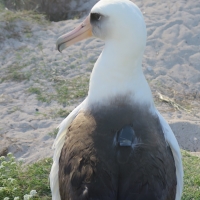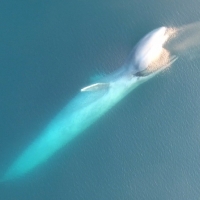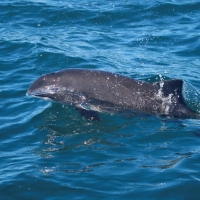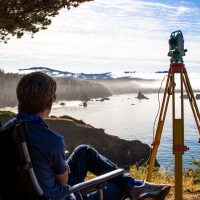 |
AMBER: Assessing Morphometrics and Behavior of Eschrichtius Robustus We are able to collect detailed behavior and body condition data using Unoccupied Aerial Systems (UAS, ‘drones’). These data will help us study how behavior varies across space, time, and individual body condition and sex. |
 |
AVENTURINE: Albatross-Vessel Encounters To Understand Risk In the North Pacific Ecosystem High-seas fisheries are often considered the wild-west: out of sight and out of control. How, when and where albatrosses interact with fishing vessels in these regions is unknown, leaving a significant knowledge gap regarding their bycatch risk. |
 |
Coastal Oregon Zooplankton Investigation (COZI) The Coastal Oregon Zooplankton Investigation (COZI) is a cross-college collaborative effort led by four early-career female scientists that aims to improve our understanding of caloric content and microplastic loads in coastal Oregon zooplankton by species, life history stage, location, and time. |
 |
DIAMOND: Drone-based Innovative Assessments of Megafauna Offering New Discoveries We are using drones and developing new tools and methods to help obtain accurate morphological measurements of marine megafauna to better monitor the health of populations in changing oceans. |
 |
EMERALD: Examining Marine mammal Ecology through Region-wide Assessment of Long-term Data We are investigating harbor porpoise and gray whale distribution patterns in the nearshore waters of the Northern California Current over three decades. |
 |
GRANITE: Gray whale Response to Ambient Noise Informed by Technology and Ecology Cetaceans are acoustically active, dependent on, and sensitive to the surrounding soundscape. Therefore, understanding the scales, intensities and types of impacts from ocean noise on their ecology and populations is a critical step toward improved management and protection. |
 |
HALO: Holistic Assessment of Living marine resources off Oregon Our mission is to understand how changes in ocean conditions influence living marine resources in Oregon waters. |
 |
JASPER: Journey for Aspiring Students Pursuing Ecological Research Providing high school and undergraduate students with an opportunity to experience ecological field research and learn valuable skills in data collection, processing and analysis has always been a central part of the TOPAZ Gray Whale Foraging Ecology Project. |
 |
OPAL: Overlap Predictions About Large whales - Identifying co-occurrence between whales and fishing effort in Oregon to reduce entanglement risk We are conducting surveys for whales aboard USCG helicopters to increase our understanding of whale distribution and habitat use patterns in Oregon waters. We will use these data to assess entanglement risk with fishing gear to inform management decisions. |
 |
SAPPHIRE: Synthesis of Acoustics, Physiology, Prey, and Habitat in a Rapidly changing Environment We are launching a multidisciplinary research program to investigate the resilience of the world’s largest animal—the blue whale—to changing ocean conditions. |
 |
SLATE: Scar-based Long-term Assessment of Trends in whale Entanglements Building on prior research using scarring patterns from photographs of whales to estimate entanglement rates, the objective of this project is to develop methods to monitor undocumented whale entanglements and the effectiveness of management measures in reducing entanglements off Oregon. We will monitor spatio-temporal changes in humpback whale entanglement rates through scar analysis, mark-recapture modeling, and enhanced community-based science. |
 |
TOPAZ: Theodolite Overlooking Predators And Zooplankton (gray whale foraging ecology) Linking predator-prey interactions is a favorite topic among ecologists, but can be expensive and challenging to accomplish at fine scales, particularly in shallow waters that limit traditional prey mapping methods. The Pacific Coast Feeding Group of gray whales forages in the Oregon near-shore environment, making them accessible for study with creative, low budget technology. |